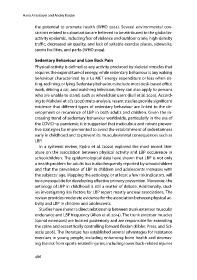Page 486 - Pedagoška vizija / A Pedagogical Vision
P. 486
Hana Al-Sobayel and Andrej Kocjan
the potential to promote health (WHO 2024). Several environmental con-
straints related to urbanization are believed to be attributed to the global in-
activity epidemic, including fear of violence and outdoor crime, high-density
traffic, decreased air quality, and lack of suitable exercise places, sidewalks,
sports facilities, and parks (WHO 2024).
Sedentary Behaviour and Low Back Pain
Physical activity is defined as any activity produced by skeletal muscles that
requires the expenditure of energy, while sedentary behaviour is any waking
behaviour characterized by a 1.5 MET energy expenditure or less when sit-
ting, reclining, or lying. Sedentary behaviours include most desk-based office
work, driving a car, and watching television; they can also apply to persons
who are unable to stand, such as wheelchair users (Bull et al. 2020). Accord-
ing to Mahdavi et al.’s (2021) meta-analysis, recent studies provide significant
evidence that different types of sedentary behaviour are linked to the de-
velopment or recurrence of LBP in both adults and children. Given the in-
creasing trend of sedentary behaviour worldwide, particularly in the era of
the COVID-19 pandemic, it is suggested that meticulous and robust preven-
tive strategies be implemented to avoid the establishment of sedentariness
early in childhood and to prevent its musculoskeletal consequences such as
LBP.
In a systemic review, Kędra et al. (2020) explored the most recent liter-
ature on the association between physical activity and LBP occurrence in
schoolchildren. The epidemiological data have shown that LBP is not only
a health problem for adults but is also frequently reported by schoolchildren
and that the prevalence of LBP in children and adolescents increases with
the subjects’ age. Mapping the aetiology, or at least a few risk indicators, will
be a prerequisite for developing effective primary prevention. Moreover, the
aetiology of LBP in childhood is still a matter of debate. Additionally, stud-
ies investigating risk factors for LBP report mostly unclear associations. The
review provides moderate evidence for the association between physical ac-
tivity and LBP in children and adolescents.
Studieshaveshown adirect relationshipbetween trunk extensormuscular
endurance and LBP frequency (Allen et al. 2014). The trunk extensor muscles
(spinal extensors) are located posteriorly and are responsible for extending
the spine and eccentrically controlling forward flexion (Kibler, Press, and Sci-
ascia 2006). The literature has established several advantages for resistance
exercises in young people, including enhancing bone health and decreas-
ing the risk from sports-related injuries, including lower back-related injuries
486

